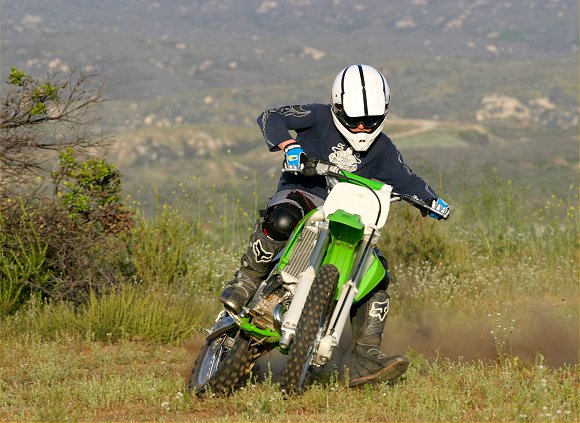
Evan Edge At Play On Our Modified KX100
When we tested the KX100 a couple of years ago, we were impressed with its all-around abilities — from motocross to play riding to trail riding. We also opined that the KX100 might be the ultimate shorter person’s off-road machine.
We asked Kawasaki if we could modify a 2002 KX100 in an effort to turn it into the ultimate trail bike for the vertically challenged rider. We also have two, uniquely qualified staff members to test such a bike (i.e., the 5’3″ Kimberly Edge (novice trail rider), and the 5’3″ Evan Edge (experienced/expert trail rider)). We were thus in the position to thoroughly evaluate a trail-tuned motocrosser with a low seat height.
As you may have guessed from the prior paragraph, the goal was to turn the KX100 into a capable trail bike with some relatively basic modifications. The KX100 starts out with an outstanding motor — fast and revvy, but with good low end for a small-bore two-stroke. We took steps to make the motor even better for trail riding by adding a ten ounce Steahly flywheel weight, an FMF fatty pipe and a U.S. Forest Service approved FMF Turbine Core II spark arrester.
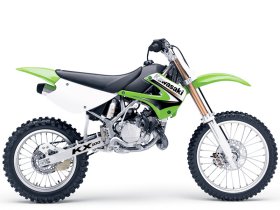
2003 Stock KX100 (unchanged from 2002 model, except for paint and graphics)
Our performance modifications really did the trick. The modified KX has an even smoother power band with virtually no hit, yet it remains powerful and torquey from just above idle to a fairly high revving top end (it doesn’t rev quite as high as stock, however). The FMF pipe boosted power just about everywhere, and the addition of the Turbine Core 2 spark arrester and the fly wheel weight mellowed everything out. Everyone who rode the modified bike was pleased with the engine performance.
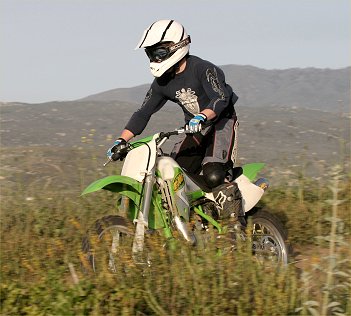
To give the KX100 more range on the trail, we swapped the OEM tank (with a 1.5 gallon capacity) for an IMS 2.4 gallon unit. The IMS tank bolted on easily enough, and kept the bike reasonably slim and ergonomically correct. It bulges upward a bit more than the stock unit, but not enough to bother either of our riders. The clear IMS tank is cool, too — you can actually see how much gas you have.
FMF also provided us with a gripper seat and a graphics kit from their 909 line of off-road products. Every FMF item we tried fit perfectly, although it took some real stretching to get the seat cover to fit without a wrinkle near the junction with the taller IMS tank (the seat cover was designed to fit over the stock seat before it was bent upward by the taller tank).
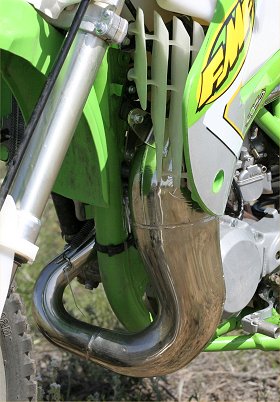
FMF Fatty Pipe Fit Perfectly and Boosted Power
With a seat height that is nearly five inches shorter than some of the stock 125cc motocross bikes out there, both of our testers felt comfortable and confident on the bike. This is particularly important for Kim, who has a lot less experience than Evan. Contributing to this comfort/confidence is the ultra-low weight of the KX100 (just 150 pounds dry — 50 pounds or so lighter than a 125). You can’t beat the power-to-weight ratio of this bike with any of the current small-bore, four-stroke play bikes. Not even close.
After the bike was fully modified, we took it out for a day of trail riding and photos. Although Mom (Kim) started out riding the bike, I asked Evan to get on the KX100 for some photos (Evan had decided, despite his lack of height, that he had graduated to the 125 class about six months ago). Specifically, I asked Evan to power slide the bike while I took pictures of him.
Evan jumped on the bike and snapped off five or six power slides (most of which ended in a crossed-up wheelie). He then handed the bike back to his Mom and said something to the effect of “That thing is fun to ride, it has a good motor.”

Our Modified KX100
Evan ended up riding the KX100 quite a bit that day, and I asked him on the way home which bike he had the most fun on (the KX100 or the KX125 he normally rides). He said “I don’t know, they were both pretty fun, but that KX100 is really easy to toss around.”
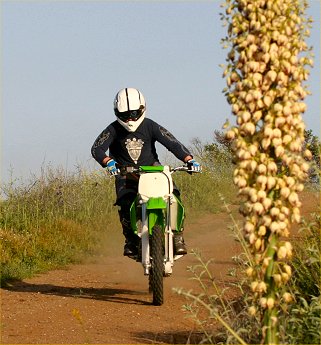
The point is this. While Evan rides fast and aggressively on the trail, the KX100 did everything he asked of it. At the same time, at his mother’s slower pace, and with her markedly lower level of experience on the trail, the KX delivered the same enjoyment and confidence.
Even in its modified state, the KX100 could still spend a day at the motocross track and perform well. That is quite a bit of versatility, and not something you would say about an unmodified four-stroke play bike (below 150cc).
With its power-valve equipped engine, and larger, stock displacement (compared to the 85cc two-strokes), the KX100 is really a unique motorcycle. It is also a motorcycle that easily met our expectations when we set out to build the ultimate trail bike for the shorter rider (novice to expert).
The new, small four-stroke play bikes have their place (and they are plenty of fun, both stock and modified), but the KX100 rules the roost when it comes to hard core, high performance capabilities (including modern suspension components) box stock. The U.S. MSRP of the 2003 KX100 is $3,449. Take a look at Kawasaki’s web site here for additional details and specifications.





